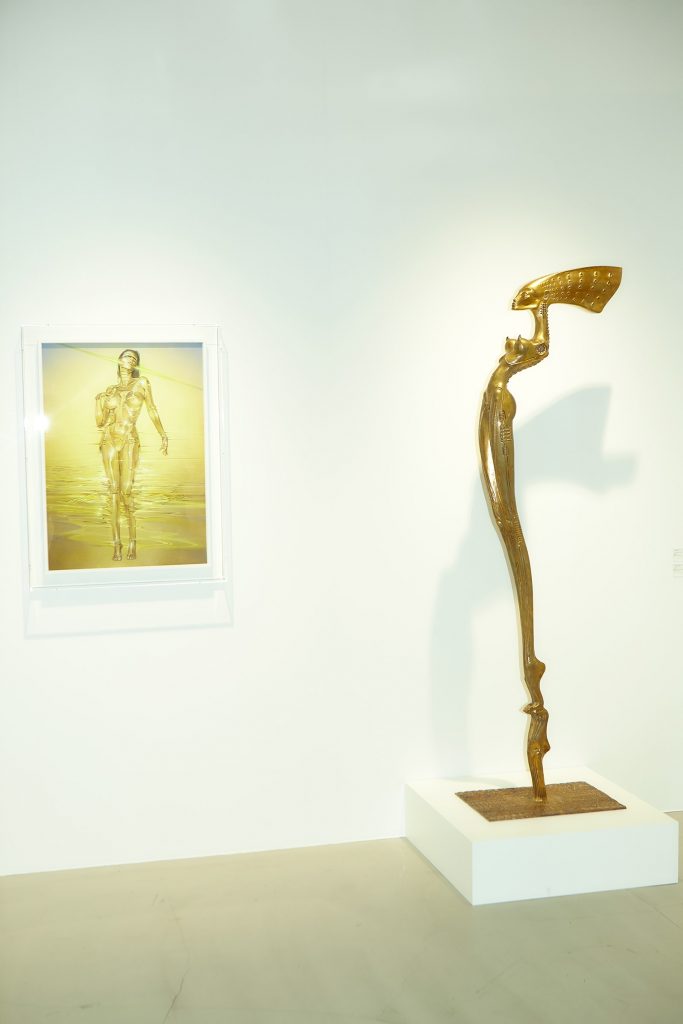Hajime Sorayama to H.R. Giger
photo: Takao Iwasawa
text: Meiji(marble studio)
translation: Hashim Kotaro Bharoocha
Hajime Sorayama’s erotic artwork continues to stir controversy today, and as can be seen in his masterpiece “Sexy Robot” which has influenced artists around the world, his highly detailed “superrealistic” airbrush art is the epitome of sensual beauty. An upcoming duo exhibition will be featuring Sorayama’s work which focuses on “sex” and “life,” coupled with artwork from H.R. Giger, who is known for his creature designs for the film Alien. In this interview we delve into Sorayama’s creative approach, his thoughts on his polar opposite counterpart, Giger, who focuses on the theme of death, and the airbrush which is a common thread in their work, as well as his explanations of his new work which is being shown in this exhibition.
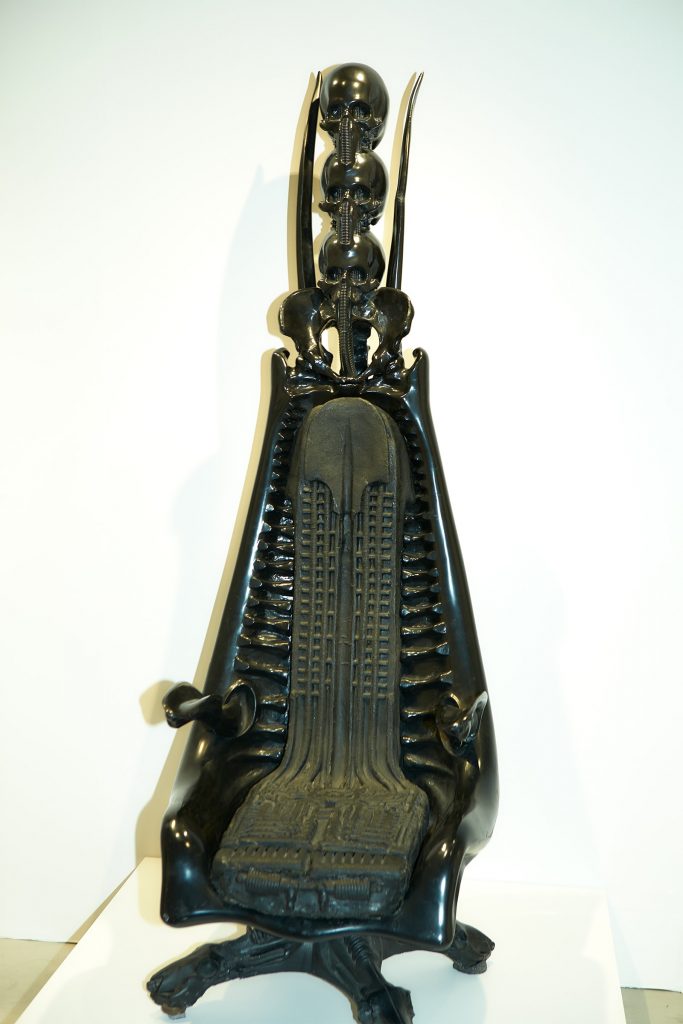
HONEYEE(H):It’s been a while since we spoke.
HAJIME SORAYAMA(S):Yeah, I’m just going to tell a bunch of lies again (laughs).
H:(Laughter) Okay, so let’s get started. The “H.R.GIGER x SORAYAMA” exhibit will be featuring works by you and Swiss painter and sculptor, H.R. Giger, but I wanted you to share your thoughts about Giger as an artist.
S:He is the polar opposite of me. It’s just like Eros and Thanatos, shadow and light, life and death. He used motifs like internal organs and bones which were considered taboo and created art out of it. He was able to get his art into the world through major outlets, but in this day and age if he was creating art, it might be considered very controversial. The spaceship and the Space Jockey in Alien honestly look like a penis to me. It’s crazy to think that a movie like that was shown in a Puritan country. That’s really going overboard in terms of breaking taboos. On the other hand, because there were trailblazers like him, it makes it easier for other people to follow in his footsteps.
H:The idea of breaking taboos is also something you have in common with him.
S:My art is basically taboo also. But compared to him, I’m a little more conscious about my relationship to society. I’m always communicating with society and thinking of how far I can take something while still being able to show it to the world. But Giger was an artist who broke down the doors of taboos, so in that sense I respect him.
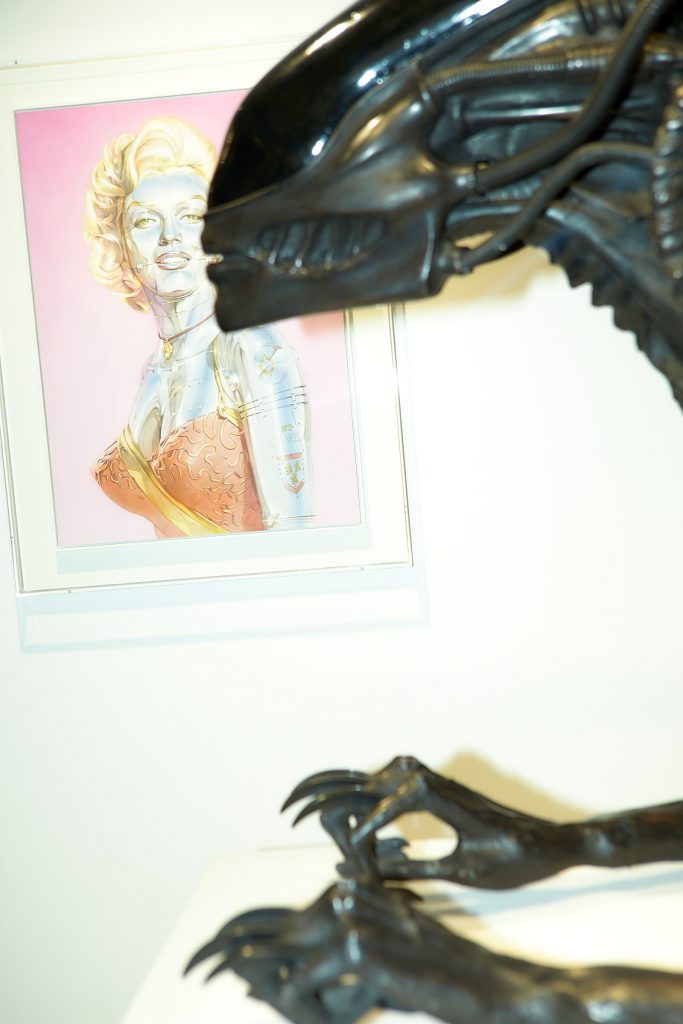
If he was alive, I would have hired him as my assistant (laughs).
H:You never got to meet Giger while he was alive, but how did this show come about?
S:There’s an Italian art magazine called KALEIDOSCOPE , and the creative director of this magazine knows Nanzuka. Apparently, this creative director came up with the idea for this project. I was going to say no if it was going to be like a garage sale where they sell prints, but when they said they were bringing Giger’s actual sculptures, I could tell they were serious, so I decided to take up their offer.
H:As you said, they brought a large number of sculptures to this show.
S:I wonder if they were sculptures that didn’t sell? Just kidding (laughs). Please write in the article that I said, “They brought in the best sculptures.”
H: I’ll write, “Sorayama told me to say that they brought in the best sculptures.” (laughs) I wanted to ask you a little more about Giger as an artist. He’s obviously well known for his creature designs for the film Alien . What are your thoughts on his unique science-fiction based approach to art?
S:It’s very morbid. He uses elements that are visually striking, but his themes are often too cryptic for me, and I wouldn’t be able to create that type of art. His themes aren’t widely accessible, so it’s not my style.
H:What are the visually striking elements that you are talking about?
S:He likes to use internal organs and membranes in his art. This is just my opinion, but I wouldn’t say that he was that technically proficient. His ability in recreating the textures of membranes wasn’t that great, don’t you think? He was primarily only able to do matte expressions.
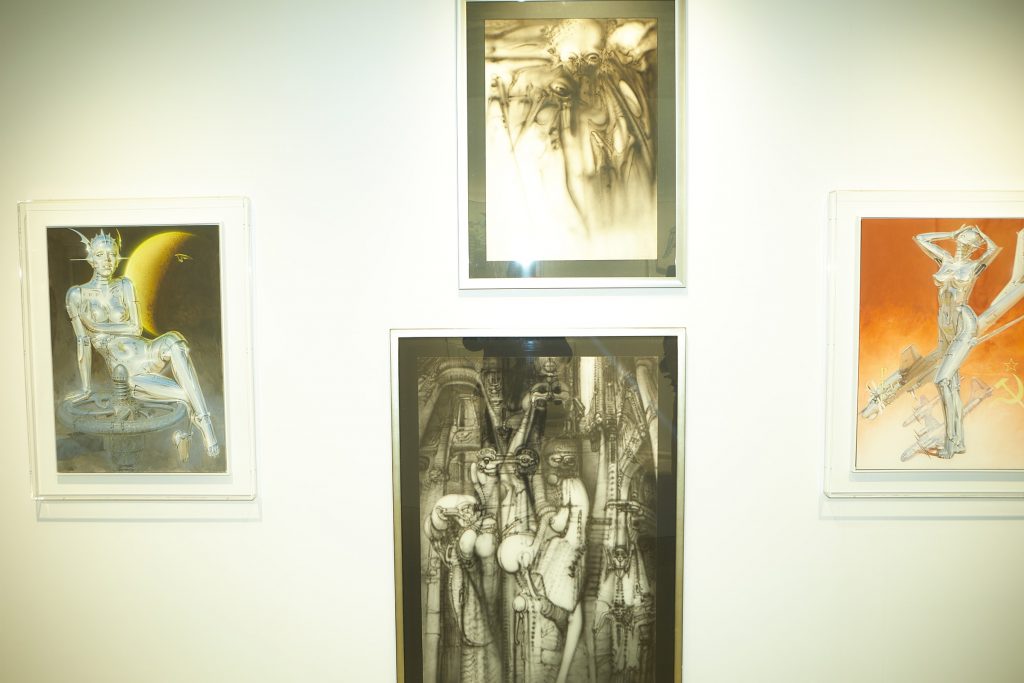
H:Both Giger and you use the airbrush. That is something you have in common.
S:In terms of the airbrush, he was highly skilled. He was an artisan. He pushed the envelope in terms of airbrush painting technique, and seeing the way he used black ink, you could tell that he wasn’t very conscious about translucence or reflection. I don’t know if that was his style, or if it was his technique, or just his aesthetic. He was also very explicit in his portrayal of sexual themes. For example, when you see graffiti in public bathrooms with sexual themes, they can be very vulgar, and that’s not something I want to do in my art. My job as an artist is to refine that expression. I’m sure that Giger was channeling more sexual energy into his art than me, but his approach was extremely raw. He was very direct.
H:But you respect his airbrush technique?
S:Yes, his technique. But Giger used the airbrush primarily, and it was as if he was being controlled by the airbrush when he was painting. In other words, I don’t think that he was somebody who was completely in control of it. In terms of an airbrush artisan and pure technique, he was miles ahead of me. But when it comes to the intuition of using the airbrush in the right place in a painting, I’d say that I’m much better at that. If he was alive, I would have hired him as my assistant (laughs).
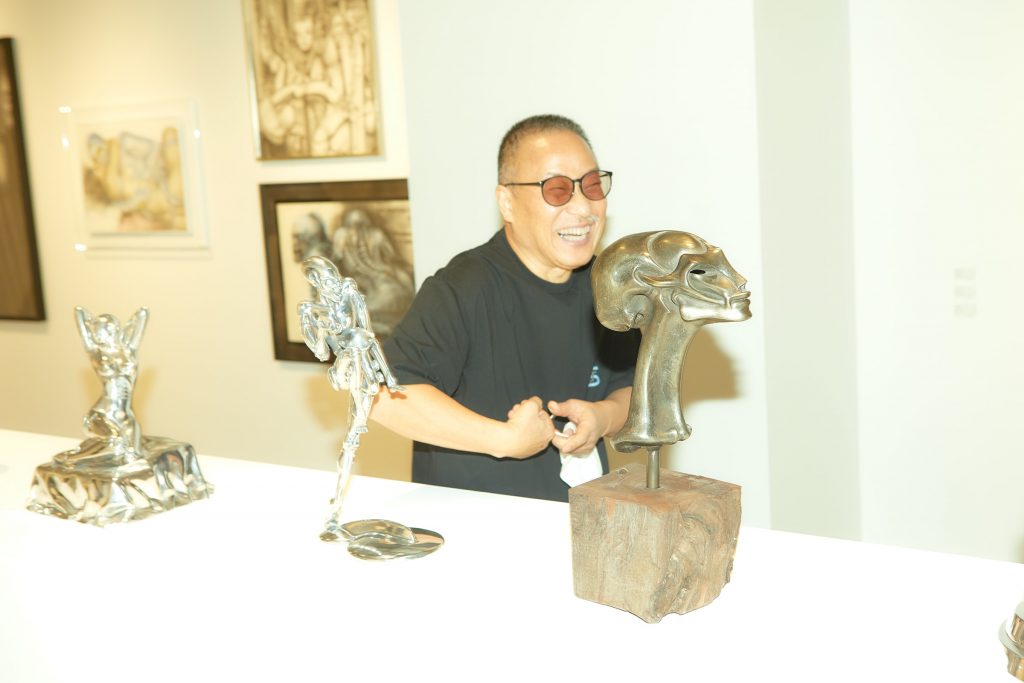
H: What are the differences between how you and Giger used the airbrush?
S:Giger’s paintings were 99% airbrush. My paintings are 5% or 10% airbrush at most. If we were chefs cooking food, Giger’s main dish would be the airbrush, but I only use the airbrush for seasoning. If I was a director, I would cast the airbrush as an actor only in key scenes. If Giger had been more in control of this tool, he would have achieved even greater heights. But if he was alive and we had a discussion about the use of the airbrush, he would have never accepted my opinion. We would have been able to respect each other, but we would probably be arguing about who’s better at using the airbrush. (laughs)
H:Does that also stem from the differences in your airbrush approaches, since you use it in the context of superrealism, while Giger comes from the world of surrealism?
S:Photorealism is basically the same as a photo, so it’s based on real objects. But his work was based on fantasy and it was self-contained. In my work, I want people to feel that my subjects actually exist in the real world, though I’m also being elusive in my expression, but that wasn’t something that was necessary for him. So, you could say that we had a different motivation or approach.
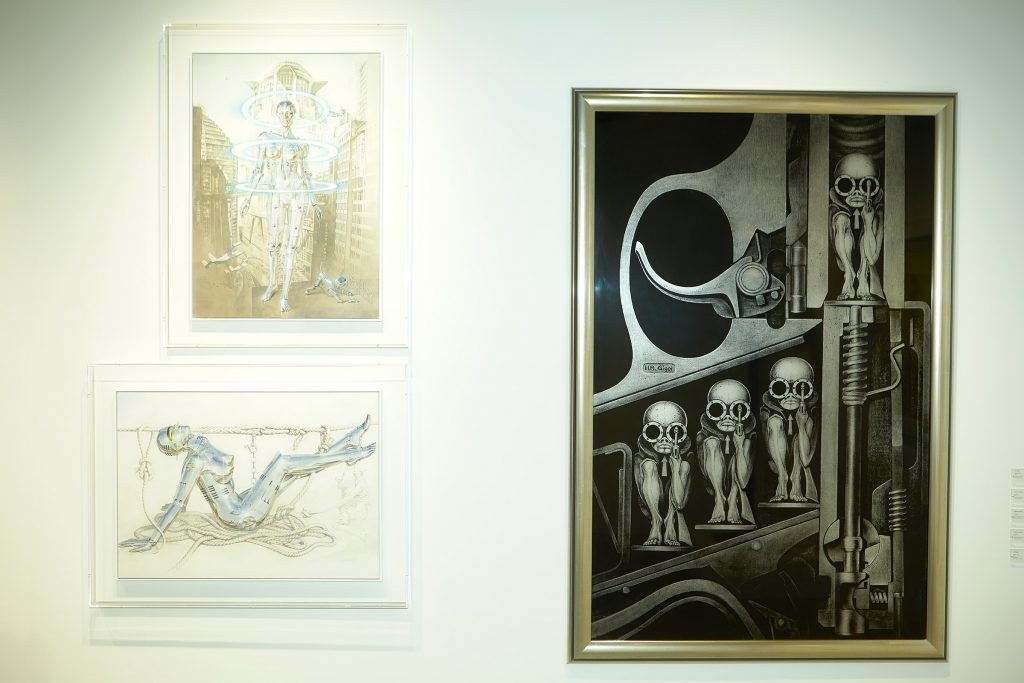
H:Your new works are also being shown at this exhibition. One of the paintings shows a woman being taken away by a trilobite with antennae with the words “Cambrian Explosion” inscribed on its body.
S:That painting is also inspired by the Burgess Shale (a deposit in the Canadian Rockies known for its fossils of marine organisms that are roughly 505 million years old). The fossils found in Burgess Shale are completely flattened. The creatures from that time period look completely different than their modern counterparts and are beyond our imagination. They have no connection to humanity and look like they are from an alternate dimension, but in a different way than Giger’s creatures.
H:The naked woman in this painting is holding an ancient Egyptian ankh. The ankh is a symbol that represents life, but were you trying to express that this woman has a strong desire to live?
S:Yes, that’s right. The organisms that were around when the Cambrian explosion happened or were found as fossils in the Burgess Shale are extinct, dead, and long gone. We humans will also be extinct sometime soon. Obviously, that’s not something that will be happening in the next one hundred or even 1000 years from now.
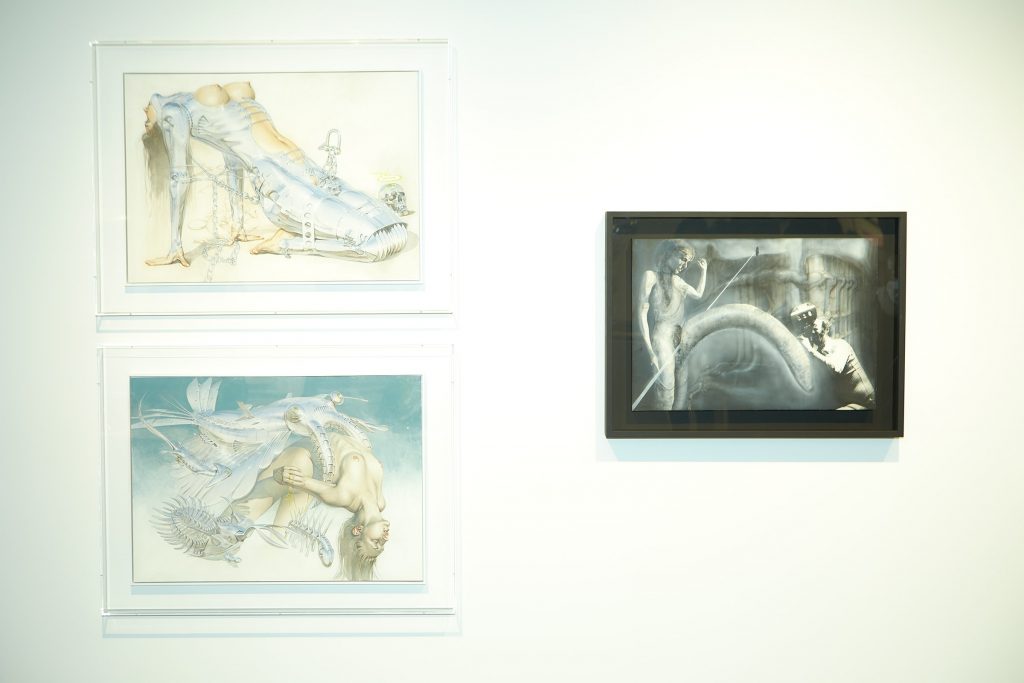
H: So that woman symbolizes modern humans?
S:Yes, as you can see, she is a living breathing human being. The painting is portraying a sex scene that happens in an alternate dimension between an extinct organism and a human.
H:So it’s very much a fantasy world. Sex has been a central theme in your work for many years. However, there is an erotic and romantic aspect to your work that is quite different from the graphic sexuality found in Shunga paintings, which makes some people feel uncomfortable.
S:If you paint a sex scene between robots, people don’t complain about it. Using robots is a convenient way to dodge the issue. In the film Bladerunner, Deckard falls in love with a replicant named Rachael, and there is a scene that alludes to them having sex. The theme in my current work is the emotion of love between living creatures and artificial objects. A human male is in love with a female robot. The Pygmalion (The king of Cyprus in Greek mythology) has Greek letters inscribed into it and Latin inscribed into the robot. So, if you take a good look you can see the writing. As long as I have those words in the painting and someone complains, I can say “Can’t you read those words?” That way I can get back at them and embarrass them. (laughs)
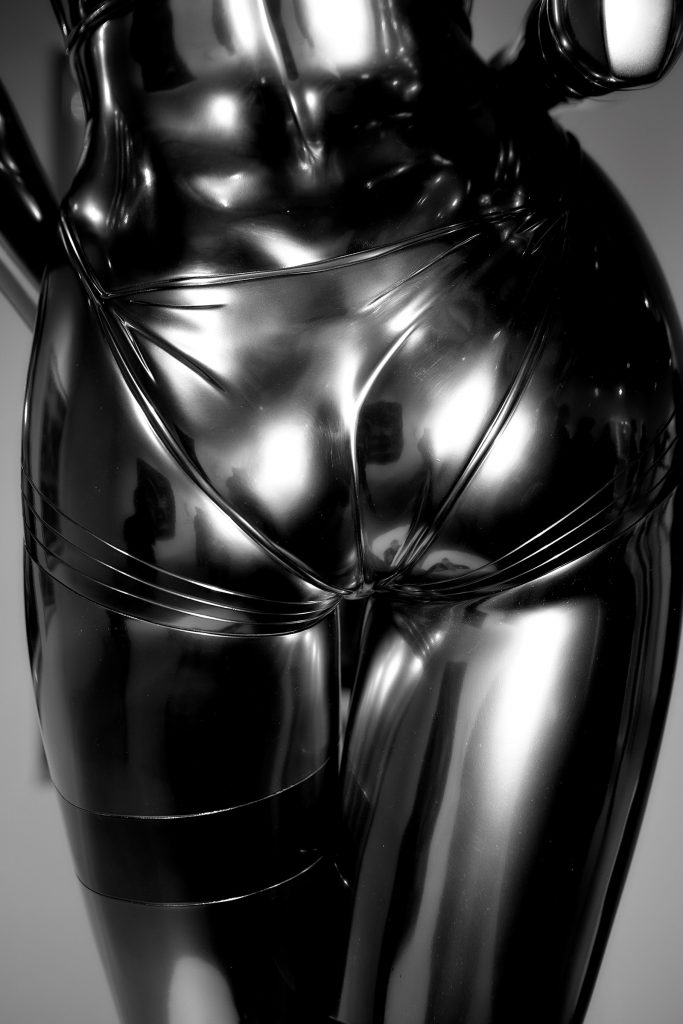
H:The words can be seen as a message to the viewer, and the fact that they are in the painting drives home the message.
S: I basically don’t title my paintings, but I do include words in them. In Katsushika Hokusai’s Kinoe No Komatsu, there is a painting called “The Dream of the Fisherman’s Wife” where an octopus is giving a woman sexual pleasure. In the past I created a painting based on that and gave it the title “To Hokusai” as an homage. The producer of the exhibit said, “The Ministry of Education is involved in the show, so don’t put any titles on the paintings.” By rejecting my art, he was also rejecting Hokusai. I have time bombs hidden up my sleeve for situations like that.
H:There are other new paintings that are being featured in this show, but can you tell us about the painting where there is a skull beside a woman who has her breasts exposed?
S:Oh, the penis painting. Can you see the creature from the movie Species that I drew faintly behind the woman’s butt? The sexy female robot is telling the Species creature to “kiss my ass” as the skull is watching. The creature is a cross between the characters in Alien and Species, so Giger fans should be able to pick up on that right away.
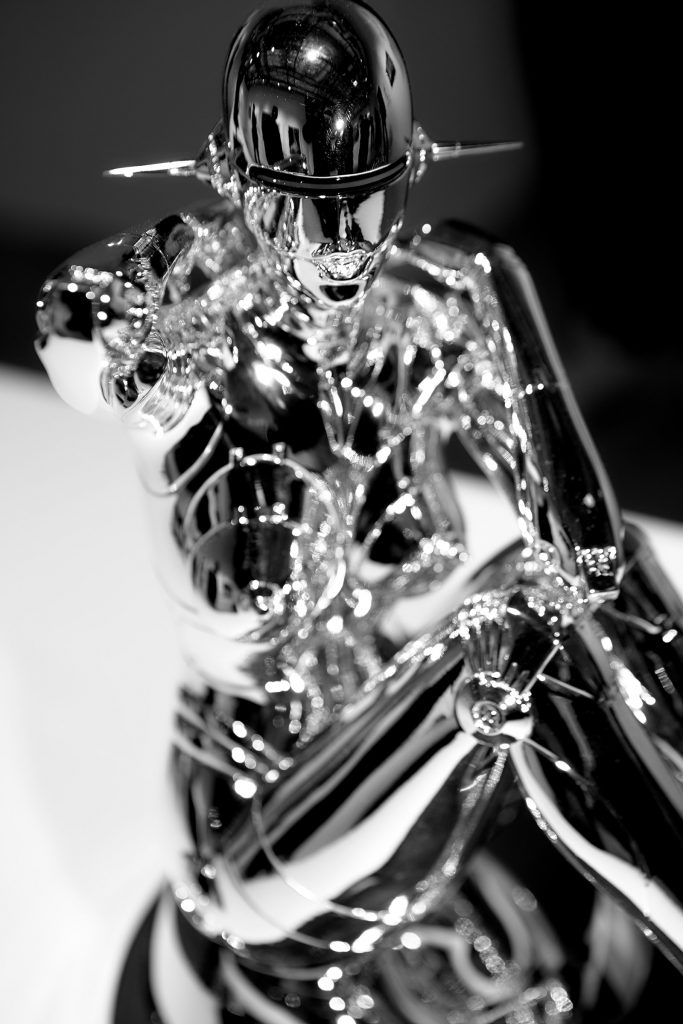
H:You’re known for painting sexy robots in your work, but you sometimes have women clad in full body armor, or sometimes parts of their bodies are exposed. What is your intention in the use of these different expressions?
S:When it comes to robots, it’s difficult to paint their facial expressions. There are different categories like sexy robots, androgynous, or humanoids, but in terms of a robot’s facial expressions, it’s difficult to paint them being in ecstasy. If I painted their fingers as completely metal, then they lose their femininity. By partially exposing their bodies, or showing their manicured fingernails, I can show their human aspect.
H:So it depends on the type of female image you want to express in that painting?
S:Absolutely. From an outsider’s perspective, it may look like I’m repeating myself and painting the same thing over and over, but there are numerous approaches I have inside of me that I can use depending on the painting. Artists often decide on a style they want to take, then become constrained to it and can’t express themselves freely. As they get older, that becomes even more apparent. The artist runs out of ideas, but the galleries and collectors keep on wanting the same style of art, so the artist is forced to imitate his own art. The artist is drawn into a vicious cycle and ultimately disappears. So as an artist, I think there is nothing wrong with having a variety of styles at your disposal. It’s like being able to deploy different types of soldiers. I’m always making sure that people are aware that I have different types of soldiers I can send out. Once you get a break as an artist, if you limit your artistic expression, then you’re going to be choking yourself. I’m sure you’ve seen people do that, right? You need to lay your bait early on, and then think about different survival tactics. That’s one of the reasons I’ve been exploring the relationship between living organisms and robots.
H:Your expression of sexuality seems to reflect a hunger for life, while on the other hand, Giger’s art seems to be focused on the theme of death. How do you confront the theme of death in your art?
S:When Eros is used as a theme in art, I use Thanatos as a type of seasoning, which brings out the flavors in my concoctions. So, I add the element of death later on in my art sometimes.
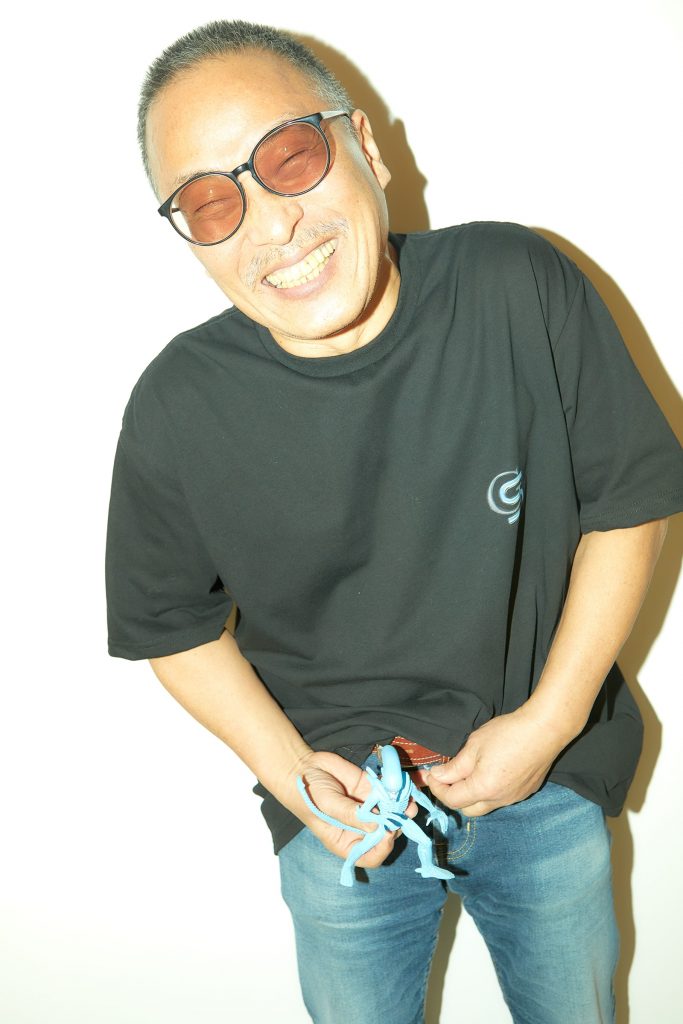
Especially when I use Latin, they think, “Oh, Sorayama knows what he’s doing.”
H:So you sometimes use “death” as a kind of gimmick in your art?
S:Yes, in those cases I will use an easily recognizable symbol for it.
H:The painting that features the creature from Species shows the German word for “death instinct” on the woman’s arm.
S:You’re talking about the word “Todestrieb.” It is a concept put forth by (Sigmund) Freud along with the term “Lebenstrieb.” It means that humans have a death drive which also makes them feel ecstasy. These drives for life and death are related to the concept of Thanatos.
H:It made me think that humans instinctually are driven towards death.
S:I’m not a sophisticated individual, so by adding those concepts in, it makes me look smart. Then the collectors start looking up those words. Especially when I use Latin, they think “Oh, Sorayama knows what he’s doing”, so I can do whatever I want elsewhere.
H:Finally, you mentioned that you and Giger are polar opposites, but how does it feel having your work shown alongside his in the same gallery space?
S:I’m flattered, but I think I won (laughs). You won’t write that in the article, will you?
